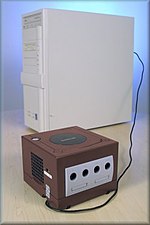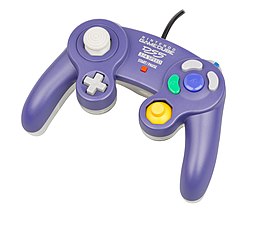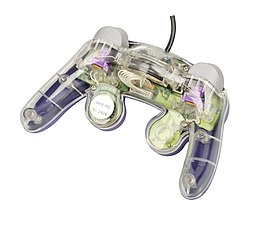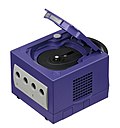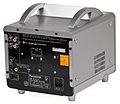History of video games/Platforms/GameCube
-
A purple GameCube with standard controller and one memory card inserted.
History
[edit | edit source]Dolphin Development
[edit | edit source]The GameCube was proceeded by the Nintendo 64. Planning for a successor console began by May 1998.[1]
The GPU of the Gamecube was developed by ArtX, a company formed in 1998 by former SGI and MIPS employees, many of whom worked on the N64.[2] The system launched with the Flipper chip for the GPU, following an acquisition of ArtX by ATI.[2]
An stereoscopic LCD attachment was considered for a 3D display, but was not considered due to cost.[3] An attempt was made to implement this on the Game Boy Advance SP, and finally actually implemented on the Nintendo DS.[3]
Both a dockable portable hybrid console GameCube, and HD supporting GameCube model was considered.[4]
-
A development GameCube connected to a computer.
-
A prototype of the GameCube controller
-
A prototype of the GameCube controller viewed from the bottom.
-
An NR reader development GameCube (left) and an NPDP reader development GameCube (right).
Launch
[edit | edit source]Born to Play—Tagline for the GameCube at launch, IGN article[5]
The highly anticipated GameCube was unveiled at Nintendo's Spaceworld 2000 convention, though playable units were not shown.[6] Spaceworld 2000 included Meowth's Party, an interactive musical tech demo.[7]
The Nintendo GameCube was released in 2001.[8]
The GameCube was not well advertised.[9]
In 2003 Nintendo President Satoru Iwata publicly voiced opposition against charging for online services for games which had already been paid for.[10]
GameCube consoles made after 2004 did not come with a Digital AV port.[11]
Legacy
[edit | edit source]
Production of GameCube consoles ended in 2007.[12] 21.74 million GameCube consoles were sold.[13][14]
The GameCube was succeeded by the Nintendo Wii, which was backwards compatible with most (but not all) GameCube games and accessories, until late model Wii consoles dropped GameCube support. The base technical architecture of the GameCube would remain in use up to the Wii U.
Immediately following the release of the Wii, both consumers and the industry quickly moved on from the GameCube. Some gamers took note of the reduced interest to pick up extremely cheap used GameCube titles as space was made for more popular products. Over time the price of GameCube titles has increased dramatically, with used games often reaching or exceeding their cost new. By 2021 some older gamers expressed surprise when a reference to the GameCube was not understood by younger gamers, indicating a cultural divide.[15]
The GameCube is remembered for its solid library of games.[13]
Technology
[edit | edit source]
The GameCube is an optimized machine for gaming and really what we've tried to do is eliminate all the bottlenecks in the processing system so that the games will run smoother.—Satoru Iwata, Interview with IGN published May 24th, 2001.[16]
Compute
[edit | edit source]The GameCube is powered by a 32-bit PowerPC Gecko CPU, a modified version of the IBM PowerPC 750CXe processor which ran at a clock speed of 486 megahertz.[17]
The GameCube has a virtual memory unit and two kinds of RAM: 24 megabytes of fast ram and 16 megabytes of slower RAM.[18]
The CPU has a 5 watt TDP, relatively low for the time.[19] The GameCube was capable of 9.4 gigaflops.[20]
Hardware
[edit | edit source]Some Gamecubes had a digital AV port, which was intended for Stereoscopic output, though this feature wasn't advertised, and the only game to support it was Luigi's Mansion.[21][22][23]
GameCube disks are 80 mm in diameter and hold 1.5 gigabytes of data.[24]
A handle was included to increase system portability.[25]
The circular plastic "jewel" featuring the logo on top of the GameCube could be swapped.[26]
Controller
[edit | edit source]The GameCube controller has dual analog triggers, allowing for pressure sensitive contexts in games.[27][28]
Notable Games
[edit | edit source]2001
[edit | edit source]Luigi's Mansion
[edit | edit source]Luigi's Mansion was a launch title for the GameCube, and gave character to Luigi.[29] This game focused on exploration, and using new powers to further that exploration.[29]
The game was also seen by reviewers as a demonstration of the GameCube's graphical power.[30]
Super Smash Bros. Melee
[edit | edit source]Super Smash Bros. Melee is a fighting game which was praised by reviewers at the time of release for improving graphics, as well as for adding 14 additional characters and generally providing a fun multiplayer experience.[31][32]
In 2020 Super Smash Bros. Melee was still a significant game in eSports.[33] The game has also been used in AI research.[34]
Pikmin
[edit | edit source]Pikmin has a unique take on real time strategy, focusing on orchestrating as many as 100 Pikmin creatures at once.[35][36]
Pikmin was well received, in part for its innovative gameplay mechanics such as allowing for up to 100 followers.[37]
To promote the launch of Pikmin, a new breed of Sutera genus flower was developed called "The Pikmin Flower".[38]
Animal Crossing
[edit | edit source]Animal Crossing is a port of the Japan only Animal Forest for the Nintendo 64, which was originally intended to release for the failed 64DD add-on.[39] The game centers around a simulated town, where time in the game corresponds with time in real life.[40]
Animal Crossing was praised by reviewers for encouraging player creativity and expression.[41]
Uniquely for the time, Animal Crossing contains a number of NES games, and can download these games to a connected Game Boy Advance.[42] The game also supported the E-Reader and other functionality with the Game Boy Advance.[43]
Star Wars Rogue Squadron II: Rogue Leader
[edit | edit source]A launch title that sold two million copies, Rogue Leader was praised for its excellent graphics, intuitive controls, and epic scale battles.[44][45]
Read more about Star Wars Rogue Squadron II: Rogue Leader on Wikipedia.
2002
[edit | edit source]
- Star Fox Adventures
- Metroid Prime
- The Legend of Zelda: The Wind Waker
- Eternal Darkness
- Mario Party 4
Super Mario Sunshine
[edit | edit source]This game is noted for its impressive water visuals.[46]
Read more about Super Mario Sunshine on Wikipedia.
2003
[edit | edit source]- Kirby Air Ride
- Final Fantasy Crystal Chronicles
- Pokémon Colosseum
- 1080° Avalanche
- Baten Kaitos: Eternal Wings and the Lost Ocean
- Star Wars Rogue Squadron III: Rebel Strike
- Viewtiful Joe
- Harvest Moon: A Wonderful Life
- Mario Party 5
- Mega Man Network Transmission
Mario Kart: Double Dash
[edit | edit source]16 players could play at the same time by using multiple GameCubes with broadband adapters.[47]
Read more about Mario Kart: Double Dash on Wikipedia.
F-Zero GX
[edit | edit source]A version of the Arcade game F-Zero AX was hidden on the F-Zero GX disk.[48]
Read more about F-Zero GX on Wikipedia.
Tales of Symphonia
[edit | edit source]This game was an incredibly important release in the Japanese market, and its release helped promote GameCube sales in Japan.[49]
Read more about Tales of Symphonia on Wikipedia.
Billy Hatcher and the Giant Egg
[edit | edit source]Read more about Billy Hatcher and the Giant Egg on Wikipedia.
2004
[edit | edit source]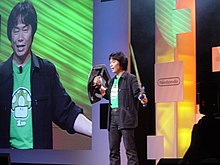
Paper Mario: The Thousand-Year Door
[edit | edit source]A quality RPG widely regarded as one of the best in the series,[50][51][52] and is sometimes considered among the finest RPGs ever made.[53]
The game would have a lasting influence, due to its discussion of surprisingly deep themes. In non English language releases, the character Vivian is represented as a transwoman, a notable inclusion for a major title at the time.[54][55][56] Later on Vivian became a symbol of Transgender gamers, due to her positive portrayal in the game, and her storyline discussing themes of familial rejection for expressing her identity[57] - an unfortunately common issue faced by many transgender people.[58]
Read more about Paper Mario: The Thousand-Year Door and Vivian on Wikipedia.
2005
[edit | edit source]- Resident Evil 4
- Chibi-Robo! (video game)
- Pokémon XD: Gale of Darkness
- Fire Emblem: Path of Radiance
- Killer7
- Harvest Moon: Magical Melody
- Mario Party 7
- Mario Superstar Baseball
2006
[edit | edit source]Special Edition GameCubes
[edit | edit source]- Panasonic Q - A version of the GameCube that can play full size DVDs and had optical out for audio.[59]
- Char edition - A late 2003 version of the GameCube themed in brilliant red after Mobile Suit Gundam character Char Aznable.[60]
- Tales of Symphonia - Japanese only "Symphonic Green" (lime green) GameCube including Lloyd decal with matching color GBA Player add on and controller, as well as a 59 block memory card and a copy of the game.[61][49]
- McDonalds Kiosk - A kiosk using a GameCube for use in McDonalds restaurants.[62]
- Starlight Gaming Station - Kiosk for hospital use.[63]
Gallery
[edit | edit source]GameCube Console
[edit | edit source]Console Versions
[edit | edit source]Panasonic Q
[edit | edit source]Controllers
[edit | edit source]Accessories
[edit | edit source]Expansion Devices
[edit | edit source]Internals
[edit | edit source]Marketing
[edit | edit source]-
GameCube Logo
-
Nintendo GameCube logotype.
-
Game Boy Player logotype.
External Resources
[edit | edit source]- Video Game Console Library - GameCube page.
- Video Game Console Library - Panasonic Q page.
References
[edit | edit source]| Parts of this page are based on materials from: Wikipedia: the free encyclopedia. |
- ↑ "GameSpy.com - Article". web.archive.org. 21 June 2006. Retrieved 27 November 2020.
- ↑ a b Peddie, Jon. "Famous Graphics Chips: Nintendo 64". Tech News. IEEE Computer Society. Retrieved 19 October 2020.
- ↑ a b "Iwata Asks". iwataasks.nintendo.com. https://iwataasks.nintendo.com/interviews/#/3ds/how-nintendo-3ds-made/0/2.
- ↑ Porter, Jon (7 September 2020). "Nintendo explored making a portable Switch-style GameCube, leak suggests" (in en). The Verge. https://www.theverge.com/2020/9/7/21425831/nintendo-leak-portable-gamecube-high-definition-wii-switch-dock.
- ↑ "Born to Play - IGN" (in en). https://www.ign.com/articles/2001/09/19/born-to-play.
- ↑ "Spaceworld 2000 - Guide". Nintendo World Report. https://www.nintendoworldreport.com/guide/1791/gamecube-faq-spaceworld-2000.
- ↑ "Meowth's Party Movie - IGN" (in en). https://www.ign.com/articles/2000/08/24/meowths-party-movie.
- ↑ "Nintendo sets GameCube price - May 21, 2001". money.cnn.com. Retrieved 28 November 2020.
- ↑ "I'll Never Love Another Console Like I Loved The Nintendo GameCube". www.vice.com. Retrieved 28 November 2020.
- ↑ "Iwata Discusses Online Plans - News". Nintendo World Report. https://www.nintendoworldreport.com/news/8683/iwata-discusses-online-plans.
- ↑ Byford, Sam (11 July 2019). "A brief history of cutdown game consoles" (in en). The Verge. https://www.theverge.com/circuitbreaker/2019/7/11/20690011/nintendo-switch-lite-game-console-redesign-xbox-playstation. Retrieved 19 October 2020.
- ↑ "Nintendo officially pulls plug on GameCube?". GameSpot. Retrieved 14 November 2020.
- ↑ a b "Gamecube". scf.usc.edu. Retrieved 14 November 2020.
- ↑ "IR Information : Sales Data - Dedicated Video Game Sales Units". Nintendo Co., Ltd. Retrieved 14 November 2020.
- ↑ "Random: Oh No, People Don't Recognise GameCubes Any More". Nintendo Life. 2 November 2021. https://www.nintendolife.com/news/2021/11/random-oh-no-people-dont-recognise-gamecubes-any-more.
- ↑ "The Big GameCube Interview: Satoru Iwata (GameCube) - IGN" (in en). https://www.ign.com/articles/2001/05/24/the-big-gamecube-interview-satoru-iwata-gamecube.
- ↑ "GameCube Architecture A Practical Analysis". Rodrigo's Stuff. 19 November 2019. Retrieved 24 December 2020.
- ↑ "Gamasutra - Postmortem: Factor 5's Star Wars Rogue Leader: Rogue Squadron II". www.gamasutra.com. Retrieved 1 November 2020.
- ↑ Shimpi, Anand Lal. "Hardware Behind the Consoles - Part II: Nintendo's GameCube". www.anandtech.com. https://www.anandtech.com/show/858/2. Retrieved 23 October 2020.
- ↑ "Console GPU Power Compared: Ranking Systems By FLOPS". GameSpot. Retrieved 4 November 2020.
- ↑ "A Visual History of the Nintendo 3DS". GameSpot. https://www.gamespot.com/gallery/a-visual-history-of-the-nintendo-3ds/2900-169/#6. Retrieved 23 October 2020.
- ↑ Linneman, John (16 December 2018). "DF Retro: the forgotten Nintendo tech that makes GameCube HDMI possible". Eurogamer. Retrieved 7 November 2020.
- ↑ "Iwata Asks". iwataasks.nintendo.com. Retrieved 7 November 2020.
- ↑ "Technical data". Nintendo of Europe GmbH. Retrieved 23 October 2020.
- ↑ "A Dolphin's Tale: The Story of GameCube — Dromble". web.archive.org. 9 January 2014. Retrieved 24 December 2020.
- ↑ Gray, Kate (6 July 2022). "Back Page: Making The Perfect Nintendo Frankenconsole". Nintendo Life. https://www.nintendolife.com/features/back-page-making-the-perfect-nintendo-frankenconsole.
- ↑ Vincent, Brittany (25 December 2020). "The Evolution of the Video Game Controller". Popular Mechanics. https://www.popularmechanics.com/technology/gadgets/g34288261/evolution-of-the-video-game-controller/.
- ↑ "Super Mario 3D All-Stars Adds GameCube Controller Support for Super Mario Sunshine - IGN" (in en). https://www.ign.com/articles/super-mario-3d-all-stars-adds-gamecube-controller-support-for-super-mario-sunshine.
- ↑ a b Minotti, Mike (10 October 2019). "The RetroBeat: Luigi’s Mansion gave Mario’s brother his own identity". VentureBeat. https://venturebeat.com/2019/10/10/the-retrobeat-luigis-mansion-gave-marios-brother-his-own-identity/. Retrieved 21 October 2020.
- ↑ Casamassina, Matt (November 16th, 2001). "Luigi's Mansion - IGN" (in en). https://www.ign.com/articles/2001/11/16/luigis-mansion. Retrieved 21 October 2020.
- ↑ "CNN.com - GameCube review: 'Super Smash Bros. Melee' - December 11, 2001". www.cnn.com. December 11th, 2001. https://www.cnn.com/2001/TECH/fun.games/12/11/super.smash.bros.idg/index.html?related. Retrieved 21 October 2020.
- ↑ "Super Smash Bros. Melee - IGN". Retrieved 5 December 2020.
- ↑ Robertson, Adi (20 November 2020). "Nintendo shuts down Super Smash Bros. tournament for using mods to play online". The Verge. Retrieved 5 December 2020.
- ↑ Parr, Ben; Dilipkumar, Deepak; Liu, Yuan (8 December 2017). "Nintendo Super Smash Bros. Melee: An "Untouchable" Agent". arXiv:1712.03280 [cs]. Retrieved 18 December 2020.
- ↑ "Pikmin - IGN". Retrieved 5 December 2020.
- ↑ "Concept to console: the history of 'Pikmin'". theboar.org. Retrieved 5 December 2020.
- ↑ Life, Nintendo (2 January 2006). "Review: Pikmin (GameCube)". Nintendo Life. Retrieved 1 November 2020.
- ↑ "Meet the Pikmin Flower - IGN". Retrieved 1 November 2020.
- ↑ "How Animal Crossing Was Born From One Of Nintendo's Biggest Flops". GameSpot. Retrieved 5 December 2020.
- ↑ "Gamasutra - Animal Crossing's Strange, Unresolved Conflict". www.gamasutra.com. Retrieved 5 December 2020.
- ↑ "Animal Crossing Review - IGN". Retrieved 8 November 2020.
- ↑ Life, Nintendo (26 May 2015). "Animal Crossing". Nintendo Life. Retrieved 5 December 2020.
- ↑ Life, Nintendo (2 January 2006). "Review: Animal Crossing (GameCube)". Nintendo Life. Retrieved 5 December 2020.
- ↑ Life, Nintendo (25 June 2013). "Review: Star Wars Rogue Squadron II: Rogue Leader (GameCube)". Nintendo Life. Retrieved 1 November 2020.
- ↑ "Even 18 Years After Release ROGUE SQUADRON 2 Is Still An Unrivaled Star Wars Experience!". GameTyrant. Retrieved 1 November 2020.
- ↑ "Nintendo Consistently Has The Best Water". TheGamer. 9 July 2021. https://www.thegamer.com/nintendo-best-water/.
- ↑ Life, Nintendo (14 September 2019). "Hardware Classics: Nintendo GameCube". Nintendo Life. https://www.nintendolife.com/news/2019/09/hardware_classics_nintendo_gamecube.
- ↑ Life, Nintendo (7 March 2013). "F-Zero AX Found Hidden In GameCube F-Zero GX". Nintendo Life. Retrieved 1 November 2020.
- ↑ a b "Japan Charts: GameCube outsells PS2 as key RPG title rolls out" (in en). GamesIndustry.biz. https://www.gamesindustry.biz/articles/japan-charts-gamecube-outsells-ps2-as-key-rpg-title-rolls-out.
- ↑ "Paper Mario: The Thousand-Year Door: Remembering it 15 years later". Nintendo Enthusiast. 22 July 2019. https://www.nintendoenthusiast.com/paper-mario-the-thousand-year-door-remembering-it-15-years-later/.
- ↑ "The Thousand-Year Door VS The Origami King: Which Is Better?". ScreenRant. 22 July 2020. https://screenrant.com/paper-mario-thousand-year-door-better-origami-king/.
- ↑ "Paper Mario: The Thousand-Year Door Is Secretly the Best Mario RPG". CBR. 10 October 2019. https://www.cbr.com/paper-mario-the-thousand-year-door-best-mario-rpg/.
- ↑ "Top 100 RPGs of All Time - IGN.com" (in en). https://www.ign.com/lists/top-100-rpgs/34.
- ↑ Phillips, Tom (17 July 2020). "Paper Mario developer discusses why you don't see original characters like Vivian anymore" (in en). Eurogamer. https://www.eurogamer.net/articles/2020-07-17-paper-mario-developer-discusses-why-you-dont-see-original-characters-like-vivian-anymore.
- ↑ "Vivian in Paper Mario" (in en). LGBTQ Video Game Archive. 11 September 2015. https://lgbtqgamearchive.com/2015/09/11/vivian/.
- ↑ "15 Classic Nintendo Games That Were Censored". ScreenRant. 3 May 2017. https://screenrant.com/classic-nintendo-video-games-censored/.
- ↑ "Paper Mario’s Vivian: Transgender Done Right The Artifice" (in en). https://the-artifice.com/paper-mario-transgender/.
- ↑ Seaman, Andrew M. (27 May 2016). "For trans people, family rejection tied to suicide attempts, substance abuse" (in en). Reuters. https://www.reuters.com/article/us-health-transgender-suicide-rejection/for-trans-people-family-rejection-tied-to-suicide-attempts-substance-abuse-idUSKCN0YI22T.
- ↑ "My Favourite Nintendo Console Wasn't Even Made by Nintendo". Kotaku. Retrieved 30 November 2020.
- ↑ "Bandai Shows off Special GC and GBA - News". Nintendo World Report. Retrieved 30 November 2020.
- ↑ "Game Cube Console - Tales of Symphonia Symphonic Green Limited Edition". www.play-asia.com. Retrieved 19 February 2021.
- ↑ "Nintendo And McDonalds: A Short History" (in en-us). Kotaku. https://kotaku.com/nintendo-and-mcdonalds-a-short-history-5498833.
- ↑ "Announcing the Starlight Nintendo Switch Gaming Station!". www.starlight.org. Retrieved 29 December 2020.


